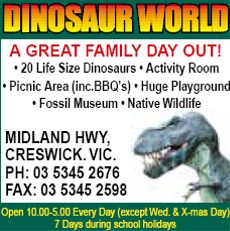 An advertisement for Dinosaur World, Creswick | |
| Location | Creswick, Victoria, Australia |
|---|---|
| Coordinates | 37°25′26″S143°53′35″E / 37.424°S 143.893°E |
| Opened | 1982 |
| Closed | 2002 |
| Theme | Dinosaurs |
| Attendance | 30,000 |
Dinosaur World (also known as World of Dinosaurs) was a theme park located 1.5km off the Midland Highway, outside Creswick, Victoria. Only 4 hectares (10 acres) large, it included around twenty life-size dinosaur models, a museum, playground and barbecue area.
Contents
Dinosaur Park was opened in 1982 by Stephanie and Bill Myers, who built the first fibreglass models himself. They later sold it to the local Plunkett family. The park was a success and described as a "Creswick tourism icon" by the Courier , attracting 30,000 annual visitors during the 1990s. However, it was sold in 2000 and closed by the new owner in 2002 because she could not afford the cost of liability insurance.


